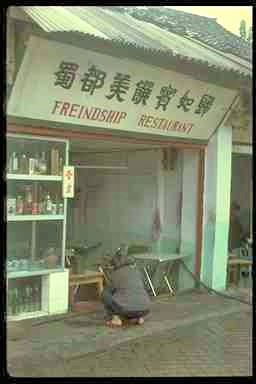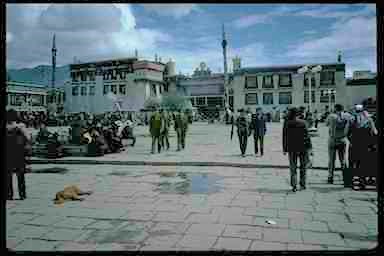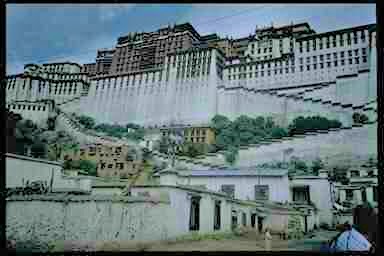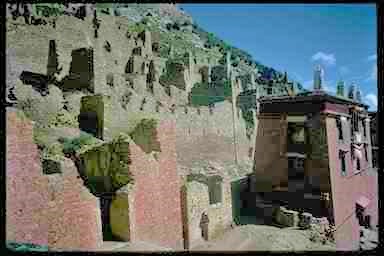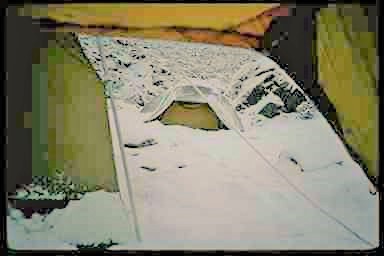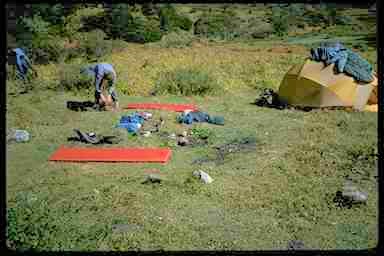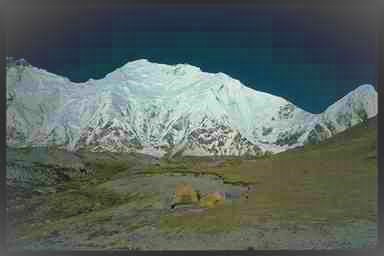TIBET MT EVEREST EAST FACE TREK
I spent my vacation this year on a 31 day trip to China and Tibet. I was gone from September 19 until October 20. The trip was very successful and the following are some of the highlights from it.
Brief Iternary
I flew to Beijing, the capital of China (Indy, Denver, Seattle, Tokyo, Beijing). We spent less than two days there playing tourist. We flew to Chengdu and spent half a day there before flying on to Lhasa, Tibet. We spent 4 days in Lhasa playing tourist. Lhasa is at an altitude of 12,000 feet and this gave us time to acclimate. Then we spent three days driving to where we were going to start the trek (Lhasa, Shigatse, Shegar, Kharta). We then spent 12 days hiking to the Mount Everest East Face Base Camp. After the trek we spent three days driving back to Lhasa and then three days flying (along with one train ride) back home (Lhasa, Chengdu, Goungzhou, Hong Kong, Seattle, Denver, Indy).
People
There were originally 6 people signed up for the trip. The one woman canceled at the last minute leaving 5 people. On driving to the point where we were going to begin the trek we went over a 16,000 foot pass and saw a stream which had a little ice in it which hadn't melted off yet. The person from Mexico City was rather shocked by this because he was not prepared for cold weather either in terms of equipment or mentally. He returned to Lhasa with the vehicles leaving 4 of us to start the trek. Half way into the hike one of the people had Acute Mountain Sickness (altitude sickness) and went out in order to return to lower altitudes leaving 3 of us to complete the trek.
Weather
The weather for 6 of the first 7 days of the trek was not too good. My prediction is that I got snowed on more on this trip than Columbus will all this coming winter. We had several days when we left camp in 2 - 3 inches of snow. The snow would eventually melt before the day was over but it still wasn't a lot of fun. The worst day was the third day of the trek. We broke camp in 3 inches of snow and started over the pass hoping that the overcast would clear. At the top of the pass we were almost in the clouds. Coming down the pass the clouds dropped and we spent the next 4 hours hiking in snow or, as we dropped lower, rain. We decided to take a rest day the next day and try to dry out. That rest day was the best weather during the first week of the trek.
The weather was perfect the last 5 days of the trek. There was always a slight overcast in the later afternoons and evenings but morning and most of the afternoon was clear. We were at high elevations most of this time and nights were very cold. We estimate that at our highest campsite the nighttime temperature dropped to around 10 degrees above zero.
Altitude
We spent a good deal of time at high altitudes. Tibet is one of the highest countries in the world. Lhasa, the capital, where we flew to is at 12,000 feet altitude. We spent over 3 weeks at 12,000 feet or higher. Our highest campsite was at 17,500 feet and we spent two nights there. One day we hiked up to 19,000 feet. The summit of Kilomanjaro is 19,000 so this wasn't a record for me. We had hoped to get to 20,000 feet and set personal records, but there didn't appear to be any place where we could do that safely and in reasonable time.
Food
I lost 12 pounds on the trip. This was mainly due to the altitude and exertion of the trip. It was NOT due to the quantity or quality of the food. We ate very well the entire time we were over there. Basically I ate Chinese food for the entire month. The exceptions were that most breakfasts were western and were usually fried or scrambled eggs. Also, some of the lunches on the trail or on the drives were somewhat western consisting of such things as hunks of sausage and cheese and granola bars.
Generally our main meals were Chinese and of various styles. In Beijing we had dinner at a restaurant and had Peking duck. In Chengdu we ate in a local restaurant and had authentic Sichuan style food. On the trek our leader, who was Chinese, did most of the cooking and we had wonderful Chinese meals. They would have been good even if we hadn't been in the back country where anything would taste good.
I had never really used chopsticks before this trip. However, when we weren't on the trek, I ate all Chinese meals with them. It wasn't until the last 4 days of the trip that I was able to use them without a great deal of thought. But up to them I was able to keep myself well fed even though I had to think about what I was doing.
Mount Everest
Basically there are 3 faces to Mount Everest, the South-West Face, the North Face and the East Face. The South-West Face can be seen from Nepal which I did 2 years ago. That view is not too good because Nupse and the west ridge both block off much view of Everest itself. You mostly only get small views and really have to work to get even those.
The East and North Faces are accessible from Tibet. The North Face is almost overrun with tourists. Well, maybe not quite that bad, but it is possible to drive almost all the way to the North Face base camp. The East Face is another story. It takes several days of hiking to see the East Face. However, once the weather cleared, we were able to see great views of it for 4 days.
There had been reports that perhaps K2 was taller than Everest based on recent measurements. The latest information (Louisville Courier-Journal, 10/26/87) is that Everest has been measured and K2 re-measured using the same technique and Everest is still the highest.
Remoteness
In some ways this was the most remote trip that I've taken. It took 3 days of driving to get from Lhasa to the trail head where we would hiking. On the trek there was places where it would take 3 or 4 days of hiking to get back to the trail head. And even then the village where we started had no medical facilities, no communications with anywhere which did and not necessarily any transportation either. In addition, we did not have a trip doctor along.
Given all this, if there had been a serious problem we realized that "Our butts were hanging way out." If someone had been seriously injured, it could have been 5 - 7 days of rough travel to get them to any help. Fortunately nothing that serious came up.
Disturbances
After we left Lhasa to start our trek we heard stories about problems in Lhasa. I heard the events referred to as "disturbances", "riots" and "uprisings". There were a number of people killed by the police.
The basic cause of the disturbances was Tibetans protesting being under Chinese control. "Splittest" is the term for someone who feels that Tibet should be an independent country. While this sounds nice, realistically China is never going to give up control of Tibet.
Our trip was almost unaffected by these disturbances. On driving back to Lhasa at the end of trek we had to go through more police checkpoints but all this involved was showing our passports. They looked at them, made sure we had valid visas and waved us on, wishing us a nice trip.
Things To Watch For
We saw a couple of other interesting groups in Tibet which may eventually be written up. The first was a group of bikers who appeared to be touring Tibet under the sponsorship of ProTec helmets. We saw them taking some pictures which looked like them were going to be used to illustrate an ad.
We also saw a group organized by Mountain Travel (the folks who organized my trip) who were going to run from Lhasa to Katmandu, Nepal. Actually they weren't going to run the entire distance, but everyone on the trip had to qualify by running a marathon under 3:15.
I plan to watch biking and running magazines over the next several months to see if any ads or articles show up based on these trips.
Follow-up
Everest is higher than K2. "Nova", the PBS science series, had a showtitled "Higher Than Everest?" and described the history and the sciencebehind the measurements.
I never saw anything about the joggers or the bikers that we saw.
